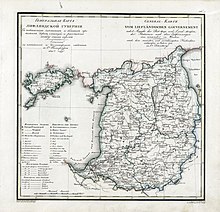Livonia Governorate
The Livonia Governorate ( Russian Лифляндская губерния / Lifljandskaja gubernija ; also Riga Governorate ) was one of the three Baltic Governments of the Russian Empire . The capital was Riga . In today's terms, the area includes the Vidzeme region in Latvia and the southern half of Estonia .
Expansion and administrative structure
The governorate of Livonia bordered in the north on the governorate of Estonia , in the east on Lake Peipus , which separated it from the governorate of Saint Petersburg , and on the governorate of Pskov , in the south-east on the governorate of Vitebsk , in the south-west on Courland and in the west on the Gulf of Riga .
It covered an area of 47,028.5 km², of which 2876 km² were islands (mainly Ösel (Estonian Saaremaa ) and Mohn (Estonian Muhu )).
The governorate was divided into nine districts ( Ujesd ):
- Dorpat (Estonian Tartu ), 1893–1918 Юрьев / Jurjew
- Fellin (Estonian Viljandi )
- Ösel (Estonian Saaremaa ), capital Arensburg (Estonian Kuressaare )
- Pernau (Estonian Pärnu )
- Riga (Lat. Rīga )
- Walk (Estonian Valga , Latvian Valka )
- Turn (Lat. Cēsis )
- Werro (Estonian Võru )
- Wolmar (Lat. Valmiera )
history
Livonia ( Swedish Livonia ) was one of the Swedish possessions that came to the Russian Empire with the Peace of Nystad in 1721 . The nobility privileges and the independence of the Lutheran Official Church were confirmed by Peter I. The Livonian knighthood in particular remained the dominant authority in the country. In 1819 the peasants were liberated , with which the Baltic Governments played a pioneering role within Russia. In 1835 the Russian code was introduced and the Russian official language was given priority. Serious Russification was not practiced until the 1880s, in particular, Russian was declared the sole official language in 1884. The Lutheran Church was also disadvantaged from this time on. There were Orthodox built churches and the Orthodox clergy tried especially the Estonian and Latvian rural population to convert to Orthodoxy. The area was occupied by German troops during the First World War in 1917/18 and in 1919 it was divided between the newly formed states of Estonia and Latvia .
statistics
In 1897 the governorate had 1,299,365 inhabitants (27.6 per km²). According to nationality, the population was divided into 563,829 Latvians , 518,594 Estonians , 98,573 Germans , 68,124 Russians , 23,728 Jews, 15,132 Poles. In terms of denomination , in 1882 there were 81.6% Protestants , 13.4% Greek Catholics , 2.4% Jews , 1% Roman Catholics . The rest was split between Armenians, small Russian churches and non-denominational groups.
The area was divided into 18.5% arable land, 24.4% forest, 41.5% meadows and pasture land and 15.6% wasteland. The population was mainly employed in agriculture, rye (1880-1884 2.2 million hectoliters), barley (1.6 million), oats (2 million), flax and potatoes (4.1 million) grown, as well as in smaller quantities wheat , hemp and buckwheat . The livestock was in 1883: 485,000 horned cattle, 216,000 pigs, 441,000 sheep and 160,000 horses. Fishing was an important branch of industry, with Breitling and flounder from the sea, smelt from the lakes and salmon from the rivers . In industrial terms, Livonia held a prominent place among the Russian governorates, it had 724 factories with 19,000 workers. Important branches of industry were distilleries, breweries, sawmills, iron foundries, oil felling, cork production, weaving and paper production. Trade was mainly conducted through the port of Riga. There were eight banks in the governorate.
In Livonia there was the University of Dorpat with 1990 students, the Riga Polytechnic with 1122, a veterinary institute in Dorpat with 150 students, 37 high schools with 7137 students, 265 schools of other types with 21,065 students and 631 rural elementary schools with 98,524 students. 24 newspapers and magazines appeared in the government, mostly in German, but some also in Latvian or Estonian.
Authorities
The governor were under a "Russian firm" for correspondence in Russian with the military authorities and a "German firm" for correspondence in German with the administrations of the districts, with the Livonian knights and with the College of Livonia and Estonian matters of Imperial Russian Government in Saint Petersburg.
literature
- Anna Ivika Laev: The situation of the peasants in the Livonia Governorate in the second half of the 19th century . Cologne 1989.
- C. Bornhaupt: Draft of a geographical-statistical-historical description of LIv-Ehst-und Kurland , Wilhelm Ferdinand Häcker, Riga 1855, pp. 77-80
Web links
- 1897 Census - Language Groups (Russian)
- 1897 Census - Administrative Division (Russian)
Footnotes
- ↑ Reinhard Wittram : Baltic history. The Baltic countries of Livonia, Estonia, Courland 1180–1918 . Scientific Book Society, Darmstadt 1973, p. 127.

